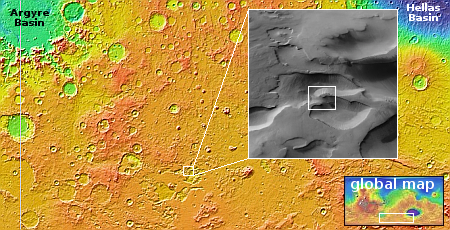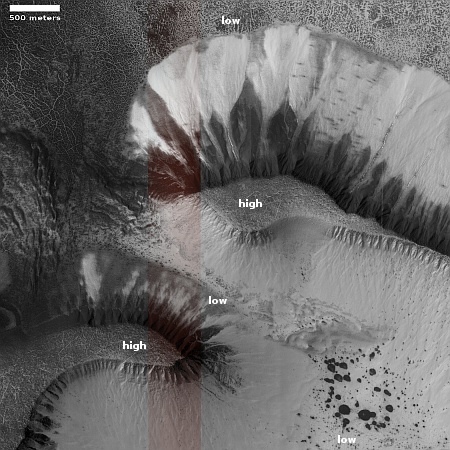Some new “What the heck?” geology on Mars
Cool image time! The picture to the right, rotated, cropped, reduced, and enhanced to post here, was taken on April 21, 2024 by the high resolution camera on Mars Reconnaissance Orbiter (MRO).
My first reaction on seeing this picture was to scratch my head? What am I looking at? Are those fluted dark features going downhill to the south, or uphill to the north? What are they? Are they slope streaks? Avalanches? How do they relate to the flat-topped ground in the middle of the picture?
I have made it easier for my readers to interpret the picture by adding the “low” and “high” markers. We are looking at two parallel thin mesas about 1,400 feet high, with the saddle between them only dropping about 350 feet.
But what about the dark fluted features? To understand what these are requires more information.

The white rectangle on the overview map to the right marks the location, in the very high latitudes (71 degrees south) of the Martian cratered highlands. The mesas are inside a complex depression dubbed Sisyphi Cavi.
Scientists have been using MRO since 2020 to monitor these mesas, because the light and dark areas appear to change drastically from Martian year to Martian year. The picture above was taken in the spring, yet it looks quite different from an earlier picture from 2020, also taken in the Martian spring. In that earlier picture the dark streaks are much smaller and the flat floor of the depression to the north is lighter, the stipples far less distinct.
At this high latitude, the ground almost certainly gets covered by the annual mantle of dry ice that falls as snow in the dark winter and then sublimates away with the coming of spring. It appears that process causes changes here. It also appears, from the label of this picture (“monitoring frost”) that orbital data has detected frost in these gullies. Both the frost and these seasonal changes could very well be what causes the gullies to erode away on the mesa slopes, with the visual changes indications of that process.
On Christmas Eve 1968 three Americans became the first humans to visit another world. What they did to celebrate was unexpected and profound, and will be remembered throughout all human history. Genesis: the Story of Apollo 8, Robert Zimmerman's classic history of humanity's first journey to another world, tells that story, and it is now available as both an ebook and an audiobook, both with a foreword by Valerie Anders and a new introduction by Robert Zimmerman.
The print edition can be purchased at Amazon or from any other book seller. If you want an autographed copy the price is $60 for the hardback and $45 for the paperback, plus $8 shipping for each. Go here for purchasing details. The ebook is available everywhere for $5.99 (before discount) at amazon, or direct from my ebook publisher, ebookit. If you buy it from ebookit you don't support the big tech companies and the author gets a bigger cut much sooner.
The audiobook is also available at all these vendors, and is also free with a 30-day trial membership to Audible.
"Not simply about one mission, [Genesis] is also the history of America's quest for the moon... Zimmerman has done a masterful job of tying disparate events together into a solid account of one of America's greatest human triumphs."--San Antonio Express-News
Cool image time! The picture to the right, rotated, cropped, reduced, and enhanced to post here, was taken on April 21, 2024 by the high resolution camera on Mars Reconnaissance Orbiter (MRO).
My first reaction on seeing this picture was to scratch my head? What am I looking at? Are those fluted dark features going downhill to the south, or uphill to the north? What are they? Are they slope streaks? Avalanches? How do they relate to the flat-topped ground in the middle of the picture?
I have made it easier for my readers to interpret the picture by adding the “low” and “high” markers. We are looking at two parallel thin mesas about 1,400 feet high, with the saddle between them only dropping about 350 feet.
But what about the dark fluted features? To understand what these are requires more information.

The white rectangle on the overview map to the right marks the location, in the very high latitudes (71 degrees south) of the Martian cratered highlands. The mesas are inside a complex depression dubbed Sisyphi Cavi.
Scientists have been using MRO since 2020 to monitor these mesas, because the light and dark areas appear to change drastically from Martian year to Martian year. The picture above was taken in the spring, yet it looks quite different from an earlier picture from 2020, also taken in the Martian spring. In that earlier picture the dark streaks are much smaller and the flat floor of the depression to the north is lighter, the stipples far less distinct.
At this high latitude, the ground almost certainly gets covered by the annual mantle of dry ice that falls as snow in the dark winter and then sublimates away with the coming of spring. It appears that process causes changes here. It also appears, from the label of this picture (“monitoring frost”) that orbital data has detected frost in these gullies. Both the frost and these seasonal changes could very well be what causes the gullies to erode away on the mesa slopes, with the visual changes indications of that process.
On Christmas Eve 1968 three Americans became the first humans to visit another world. What they did to celebrate was unexpected and profound, and will be remembered throughout all human history. Genesis: the Story of Apollo 8, Robert Zimmerman's classic history of humanity's first journey to another world, tells that story, and it is now available as both an ebook and an audiobook, both with a foreword by Valerie Anders and a new introduction by Robert Zimmerman.
The print edition can be purchased at Amazon or from any other book seller. If you want an autographed copy the price is $60 for the hardback and $45 for the paperback, plus $8 shipping for each. Go here for purchasing details. The ebook is available everywhere for $5.99 (before discount) at amazon, or direct from my ebook publisher, ebookit. If you buy it from ebookit you don't support the big tech companies and the author gets a bigger cut much sooner.
The audiobook is also available at all these vendors, and is also free with a 30-day trial membership to Audible.
"Not simply about one mission, [Genesis] is also the history of America's quest for the moon... Zimmerman has done a masterful job of tying disparate events together into a solid account of one of America's greatest human triumphs."--San Antonio Express-News



That is some concentrated weirdness right there!
A couple of good sized sand worms there.